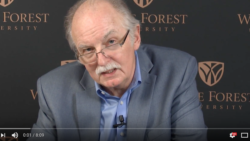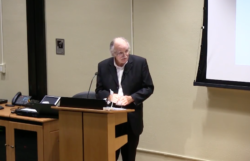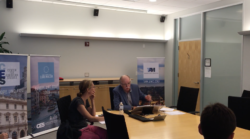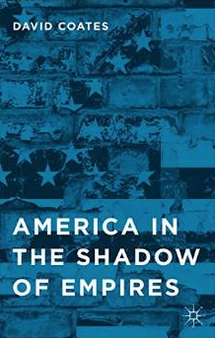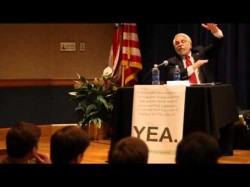Immigration and the Problem of the Two-Legged Stool
(co-authored with Peter Siavelis)
 It is less than a year (November 2009) since Janet Napolitano – the Homeland Security Secretary and the administration’s point person on immigration – announced her and the President’s commitment to a three-pronged approach to the issue of immigration reform. The Obama administration, she said, would (1) streamline the system of legal immigration, and (2) intensify the scale of deportations, in part to create a supportive political environment for (3) comprehensive legislation that would, among other things, allow a “tough and fair” route to legality for undocumented workers already here.[1] That same three-pronged approach was advocated again by the President in July, though by then the emphasis had shifted from streamlining the system of legal immigration to securing the border to prevent illegal immigration.[2] This ‘three legged stool” approach remains the administration’s official policy position. Unfortunately, thus far at least, the implementation of that policy has been one crucial leg short.
It is less than a year (November 2009) since Janet Napolitano – the Homeland Security Secretary and the administration’s point person on immigration – announced her and the President’s commitment to a three-pronged approach to the issue of immigration reform. The Obama administration, she said, would (1) streamline the system of legal immigration, and (2) intensify the scale of deportations, in part to create a supportive political environment for (3) comprehensive legislation that would, among other things, allow a “tough and fair” route to legality for undocumented workers already here.[1] That same three-pronged approach was advocated again by the President in July, though by then the emphasis had shifted from streamlining the system of legal immigration to securing the border to prevent illegal immigration.[2] This ‘three legged stool” approach remains the administration’s official policy position. Unfortunately, thus far at least, the implementation of that policy has been one crucial leg short.
Certain things have happened.
- The border has been strengthened. As the President said in July, we now “have more boots on the ground near the Southwest border than at any time in our history.” The Border Patrol has nearly doubled in personnel since 2004, to almost 20,000 people. ICE has a quarter of all its personnel now located in the Southwest. The Obama administration has sent an extra 1200 National Guardsmen to the frontier; and the border now has “at least 300 miles of vehicle barriers, 370 miles of fencing, and 105 ground-based radar and camera towers.”[3] In 2009, “illegal crossings along the Southwest border were down 23%, to a fraction of their all-time high.”[4] To quote the President again, “the bottom line is this: the southern border is more secure today than at any time in our history.”[5]
- The rate of deportations has quickened. “According to the Department of Homeland Security, nearly 359,000 immigrants were removed in 2008, up from 18,000 in 1980.”[6] In 2009, changing tack slightly, ICE conducted audits of employee files at more than 2,900 companies – levying a record $3 million in fines on companies employing undocumented workers – and in the process making a record 279,000 deportations in the first 9 months of the 2010 fiscal year. That scale of deportation constituted a 10 percent increase on the same period in the last fiscal year of the Bush administration, and was nearly twice the level of deportations for the whole of 2005. It is moreover significant that, for all the administration’s emphasis on primarily expelling people with criminal records, fifty-one percent of those deported in 2009-10 had no criminal record, and many of those who on paper had such a record were simply guilty of “driving with broken tail lights or stopped and don’t have a license!”[7]
So the border is secure and the rate of deportations increased – two legs of the stool well and truly in place. But we have yet to see any concerted effort by the administration to introduce comprehensive immigration reform, or indeed systematically to streamline the system of legal immigration. There is, to date at least, no third leg.
Why?
- Initially because the President was waiting on a cross-party Senate initiative led by Lindsey Graham and Charles Schumer. The problem with that waiting, of course, is that if cross-party unity on this issue is the administration’s goal they are likely to wait forever. Cross-party dealing on immigration is no longer a runner – the Tea Party people have seen to that – and, anyway, Lindsey Graham has thrown in the towel. He has thrown it in big time – telling the President to abandon any notion of comprehensive immigration reform (or energy reform) this side of the mid-term elections, and even (to his perennial shame) adding his voice to those advocating the repeal of the 14th Amendment. Graham is on record as criticizing heavily pregnant undocumented female immigrants for “dropping babies” to win citizenship for the newborn child and a lower chance of deportation for the baby’s parents.[8] He and other leading Republicans have recently made a big deal about such anchor babies – even though the latest Pew-based research gives the number of births among undocumented workers in 2008 as just 340,000, out of a total number of new babies in the United States that year of 4.3 million.[9]
- Because now attention has shifted to the fight in Arizona over SB 1070.[10] To its credit, the administration has thrown the Justice Department into action against the Arizona law, and brought pressure to bear on the most blatant of all the Arizona actors in the deportation drama – Sheriff Arpaio of Maricopa County. But even when being this pro-active, the main thrust of the administration’s challenge is not that the Arizona law requires racial profiling and constitutes an infringement of the civil rights of legal U.S. citizens. No, the case being made is that Arizona is usurping an area of public policy reserved by the Constitution to the federal level. In the court of law, the constitutional argument on “pre-emption” may well hold: but in the court of public opinion, so too might the thrust of the counter-case: that Arizona needs to act because of the absence of federal policy. And sending more troops to the Arizona border – which the administration has now done – quite simply surrenders to conservative forces the entire framing of the argument: that this problem is primarily a border issue, and that only local legal initiatives can trigger an effective federal response.
The Arizona initiative has reinforced the general Republican Party retreat from bipartisanship which now dominates Washington politics.[11] By poisoning the well of bi-partisanship on the immigration issue, SB 1070 has made passing comprehensive reform that bit more difficult. But by poisoning that well, the Arizona initiative has also presented the administration with a clear opportunity: to make the issue of comprehensive immigration reform uniquely its own, and to lock in the growing Latino vote for a generation. But to do that, the administration would actually have to introduce legislation and make the public case for its immediate necessity. It would have to put its feet where its mouth is.
The opportunity is there. The need is there. The only thing that would appear to be missing is the political will to meet that need by exploiting this opportunity to the full. Triangulation should only go so far – and on immigration reform, that limit has long been crossed.[12]
Therefore we should say, loud and strong to the Obama White House, these four things.
- The moral case for comprehensive immigration reform grows stronger by the day. Remember the three F’s – fear, foreclosures and fatalities. Fear currently stalks the Latino community, and not just in Arizona – fear that is keeping the Latino community, documented or otherwise, away from the full use of existing services.[13] We have new research data to show what many of us have long known: that “a majority of Hispanics worry that they, or someone they know, will be deported… [with] fewer than half of Latinos…confident that police officers in their community treat Hispanics fairly.”[14] Such fear even impacts on the foreclosure crisis;[15] and it certainly impacts on the mortality figures. We have dreadful new figures from the Arizona morgues: 40 bodies found in the Arizona desert in just the first two weeks of July 2010, and 57 by the end of the month – the highest numbers for more than five years![16] Inaction in this context has real consequences. Standing back and doing nothing is not an option; and that is not just our opinion. It is now the view of an increasing number of Protestant Evangelical organizations long associated, not with the Democratic Party but with the Republicans.[17]
- The economic case for comprehensive immigration reform also remains intact and pressing.[18] Data recently produced for the Labor Markets Initiative of the Migration Policy Institute reconfirms the standard general view that “in the long-run, immigrants do not reduce native employment rates but…do increase productivity and hence average income.” It is true that during downturns in the economy, as now, “new immigrants are found to have a small negative impact on native employment in the short run (but not the long run);”[19] but that negative impact nowhere matches the cost of recent policy moves to capture and expel undocumented workers. So it remains the case that “a more constructive immigration policy would aim to generate productivity gains to the U.S. economy while limiting the fiscal cost and keeping enforcement spending contained…by converting existing flows of illegal immigrants into legal flows.”[20] Not walls, but routes to citizenship.
- The electoral case for comprehensive immigration reform is still compelling. There are no large blocks of white votes to lose that have not already been lost – the kind of white vote lost on immigration is inherently a Tea Party vote beyond the reach of Democratic backsliding. But the Latino vote is there to be won and held. The progressive vote is there to be won or alienated; and an entire electorate is still there to be shaped. Ask a broad sweep of Americans if they support the Arizona law, and in the absence of anything else being discussed around them, significant majorities do. But ask those same people if Hispanic workers are discriminated against and if comprehensive immigration reform is needed, and significant majorities agree with that also. Which face of the general electorate prevails on this issue will therefore be fixed not by immigration numbers but by political leadership – either that from Fox News or that from the Obama White house.
- The diplomatic case for comprehensive immigration reform needs also to be factored in. The lack of comprehensive immigration reform imperils U.S. diplomacy in Latin America, undermining U.S. interests in the region and beyond. The U.S.’s immigration model has historically provided the best and brightest immigrants and students the chance to succeed, reinforcing the notion internationally of the U.S. as the land of opportunity. Workers who stay in the U.S. provide living proof of this reality and international students take back a positive image of the U.S. to their home countries. Tighter immigration has undermined both of these processes, and hurt the reputation of the United States internationally, as visitors become increasingly frustrated with the hostility and suspicion in the visa process. In more concrete terms, the lack of immigration reform has poisoned the well of U.S.-Latin American relations, and particularly U.S.-Mexican relations. Mexico is the U.S.’s second largest trading partner after Canada and an important gateway to markets farther south. The inability to achieve reform interferes with the deepening of mutually beneficial economic relations and complicates joint efforts at progress toward a solution to the scourge of narco-trafficking. The scathing condemnation of Arizona’s immigration law by Venezuelan President Hugo Chavez and a group of Cuban parliamentarians provides ample evidence of how the immigration impasse also provides negative diplomatic ammunition to avowed enemies of the U.S.
The politics of bait and switch will produce neither immigration reform nor a strong progressive majority in Washington. The Latino community needs the first. The Obama presidency – to last beyond 2012 – needs the second. Two-legged stools cannot sustain forever those who sit on them. Eventually, without the third leg, the sitter is bound to fall. It is time to build more stable furniture – time that is rapidly running out!
[1]In November Secretary Napolitano used the occasion of an address to the liberal Center for American Progress to confirm an intended push for comprehensive legislation early in 2010, legislation on what she called the “three-legged stool” of tougher enforcement against illegal immigrants and their employers, a streamlined system for legal immigration, and a “tough and fair pathway to earned legal status” for immigrants already illegally here. For details, see https://www.davidcoates.net/2010/01/18/immigration-the-story-in-2009/. The full text is at http://www.dhs.gov/ynews/speeches/sp_1258123461050.shtm
[2] “ To begin with, our borders have been porous for decades.” The full text is at http://www.whitehouse.gov/the-press-office/remarks-president-comprehensive-immigration-reform
[3] Michele Waslin, The Border Is More Secure Today Than Ever Before – Now What? Posted on alternet.org, June 29, 2010: available at http://www.alternet.org/story/147371/
[4] Alan D. Bersin & John Morton , ‘What We’re Doing to Secure the Border”, The Wall Street Journal, July 29, 2010. (Bersin is the commissioner of U.S. Customs and Border Protection; Morton is the director of U.S. Immigration and Cusoms Enforcement [ICE].)
[5] See note 2 for the text
[6] Pew Hispanic Center Fact Sheet, Hispanics and Arizona’s New Immigration Law, April 29, 2010: available at http://www.pewhispanic.org/files/factsheets/68.pdf
[7] This data(and quotation) from Miriam Jordan, “Deportations Increase Sharply,” The Wall Street Journal, August 3, 2010; see also Julia Preston, ‘Illegal workers Swept From Jobs in “Silent Raids’’, The New York Times, July 9, 2010. The decision to extend the “Secure Communities” program to all 25 border counties in Arizona is particularly troubling. That program obliges law enforcement to send to ICE the fingerprints of anyone arrested. 79% of those deported under the program thus far have no criminal record! (The New York Times, August 17, 2010)
[8] Julia Preston, “Citizenship From Birth Is Challenged on the Right,” The New York Times, August 6, 2010; and Seth Hoy, Argument Against “Birthright citizenship” So Flawed That Even Some Conservatives Don’t Buy It, posted on alternet.org August 16, 2010: available at http://www.alternet.org/story/147856/
[9] Featured Research: Unauthorized Immigrants and Their U.S.-Born Children, The Pew Hispanic Center, August 11, 2010: available at http://www.pwehispanic/org
[10] For earlier overviews, see https://www.davidcoates.net/2010/05/05/chapter-7-may-2010-update/ and https://www.davidcoates.net/2010/06/05/crossing-arizona-stalemate-in-the-desert/
[11] The administration can’t even get bipartisan support for the DREAM Act, but easily passed (in a week) a $600 million bill to fund 1500 new border agents and unmanned surveillance drones. For earlier overviews of this lack of bipartisanship, see https://www.davidcoates.net/2010/04/25/stumbling-over-a-mess-of-your-own-making-arizona-and-immigration-reform/ and https://www.davidcoates.net/2010/07/02/moderate-republicans-going-south/
[12] As Adam Serwer put it, “while President Obama talks like an immigration moderate, in practice his actions are those of an unapologetic immigration hawk who has tightened border security without fulfilling his promise of immigration reform.” Adam Serwer, “Obama is an Immigration Hawk”, The American Prospect, August 12, 2010: available at http://www.prospect.org/cs/articles?article=obama_is_an_immigration_hawk
[13] “A new demographic and economic profile of Latinos, based on 2008 census data, finds they are twice as likely as the overall U.S. population to lack health insurance coverage.” (Pew Hispanic Center, August 11, 2010). See also Tara Watson, Inside the Refrigerator: Immigrant Enforcement and Chilling effects in Medicaid Participation, NBER Working Paper No. 16278, August 2010: “up to seventy-five percent of the relative decline in non-citizen Medicaid participation around the time of welfare reform, which has been attributed to the chilling effects of the reform itself, is explained by a contemporaneous spike in immigration enforcement activity.”
[14] Pew Hispanic Center Fact Sheet, Hispanics and Arizona’s New Immigration Law, op.cit, p. 3
[15] Seth Hoy, Another Unintended Consequence of AZ Immigration Law: More Foreclosures and Vacant Homes, posted on alternet.org June 15, 2010: available at http://www.alternet.org/story/147211/.
[16] Edward Schumacher-Matos, ‘Immigration reform is within our grasp. Meanwhile, people die.” The Washington Post, July 22, 2010; and James C. McKinley Jr., “An Arizona Morgue Grows Crowded,” The New York Times, July 28, 2010
[17] Eric Marrapodi, Religious conservatives want immigration reform, CNN.com, June 10, 2010; and Laurie Goodstein, “Obama Gains Evangelical Allies on Immigration”, The New York Times, July 18,2010
[18] For an earlier overview, see our jointly written pieces https://www.davidcoates.net/2010/02/22/immigration-reform-in-a-time-of-recession/ and https://www.davidcoates.net/2010/03/23/the-invisible-immigration-rally/
[19] Giovanni Peri, The Impact of Immigrants in Recession and Economic Expansion, Washington DC: MPI, 2010: available at http://www.migrationpolicy.org/ The general case is surveyed in chapter 6 of David Coates & Peter Siavelis (editors), Getting Immigration Right: What Every American Needs to Know, Dulles VA; Potomac Books, 2009.
[20] Gordon H Hanson, The Economics and Policy of Illegal Immigration in the United States, Washington DC: MPI, December 2009: available at http:// www.migrationpolicy.org/pubs/Hanson-Dec09.pdf
David Coates holds the Worrell Chair in Anglo-American Studies at Wake Forest University. He is the author of Answering Back: Liberal Responses to Conservative Arguments, New York: Continuum Books, 2010.
He writes here in a personal capacity.
